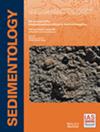Siderite from the Tibetan Himalaya: Evidence for a low sulphate ocean during Oceanic Anoxic Event 1a (Early Aptian)
IF 2.8
2区 地球科学
Q1 GEOLOGY
引用次数: 0
Abstract
Mesozoic oceanic anoxic events were characterized by relatively low seawater sulphate concentrations ([]), which likely regulated the development and evolution of these major palaeoceanographic phenomena. However, there is little reliable sedimentary evidence for low [] in ancient marine waters and understanding of how such a seawater chemistry potentially impacted oceanic anoxic events is limited. This study presents an integrated sedimentological, mineralogical and geochemical investigation of the mineral siderite hosted in dark grey shale and sideritic concretions of Early Aptian (coeval with Oceanic Anoxic Event 1a) from the Tibetan Himalaya. Siderite is present throughout the section and possesses similar morphological characteristics whether in dark grey shale or concretions. Siderite can be present as disseminated and rhombic crystals formed during early diagenesis, or minor spherical crystals formed during late diagenesis. The evidence from redox elements, middle rare‐earth element bulge patterns and extremely low carbon‐isotope values of the sideritic concretions indicates that the iron carbonate was formed in the Fe‐reduction zones by the process of dissimilatory iron reduction. This process would have required conditions of low [], reducing environment, abundant iron and high alkalinity. Additionally, the coexistence of siderite and pyrite may indicate that dissimilatory iron reduction occurred close to the microbial sulphate reduction zone, with seawater [] hovering around the tipping point at which pyrite could form once seawater sulphate increased. Such an increase during Oceanic Anoxic Event 1a could have resulted from basalt–seawater interaction and associated enhanced continental weathering, and/or hydrothermal activity. This study's observations support the previous hypothesis that low [] for Oceanic Anoxic Event 1a was probably caused by massive gypsum burial in the proto‐South Atlantic. Subsequently, enhanced sulphate input could have promoted microbial sulphate reduction and accompanying oxidation of organic matter, which likely further enhanced nutrient recycling, increased primary productivity and organic‐carbon burial, leading to more oxygen consumption and expansion of oxygen minimum zones, as reconstructed for many oceanic anoxic events.西藏喜马拉雅山脉的菱铁矿:大洋缺氧事件 1a(早古生代)期间低硫酸盐海洋的证据
中生代大洋缺氧事件的特点是海水硫酸盐浓度([])相对较低,这可能制约着这些重大古海洋现象的发展和演变。然而,几乎没有可靠的沉积物证据表明古代海水中的[]浓度较低,人们对这种海水化学性质如何对大洋缺氧事件产生潜在影响的了解也很有限。本研究对西藏喜马拉雅山早安普世(与大洋缺氧事件 1a 同时发生)深灰色页岩和菱铁矿凝块中的菱铁矿进行了沉积学、矿物学和地球化学综合研究。菱铁矿存在于整个剖面中,无论是深灰色页岩还是凝结块,都具有相似的形态特征。菱铁矿可以是成岩早期形成的散粒和菱形晶体,也可以是成岩晚期形成的小球形晶体。从氧化还原元素、中间稀土元素隆起形态以及菱铁矿凝结物中极低的碳同位素值来看,碳酸铁是在铁还原带中通过异纤铁还原过程形成的。这一过程需要低[]、还原环境、丰富的铁和高碱度的条件。此外,菱铁矿和黄铁矿的共存可能表明,异嗜性铁还原发生在微生物硫酸盐还原区附近,海水[]在临界点附近徘徊,一旦海水硫酸盐增加,黄铁矿就会形成。大洋缺氧事件 1a 期间的这种增加可能是由于玄武岩与海水的相互作用以及相关的大陆风化增强和/或热液活动造成的。本研究的观测结果支持之前的假设,即大洋缺氧事件 1a 期间的低[]可能是由原南大西洋的大量石膏埋藏造成的。随后,硫酸盐输入的增加可能促进了微生物的硫酸盐还原作用和随之而来的有机物氧化作用,这很可能进一步促进了营养物质的循环、初级生产力的提高和有机碳的埋藏,从而导致更多的氧气消耗和最小含氧区的扩大,正如许多大洋缺氧事件重建的那样。
本文章由计算机程序翻译,如有差异,请以英文原文为准。
求助全文
约1分钟内获得全文
求助全文
来源期刊

Sedimentology
地学-地质学
CiteScore
8.20
自引率
11.40%
发文量
94
审稿时长
6-12 weeks
期刊介绍:
The international leader in its field, Sedimentology publishes ground-breaking research from across the spectrum of sedimentology, sedimentary geology and sedimentary geochemistry.
Areas covered include: experimental and theoretical grain transport; sediment fluxes; modern and ancient sedimentary environments; sequence stratigraphy sediment-organism interaction; palaeosoils; diagenesis; stable isotope geochemistry; environmental sedimentology
 求助内容:
求助内容: 应助结果提醒方式:
应助结果提醒方式:


